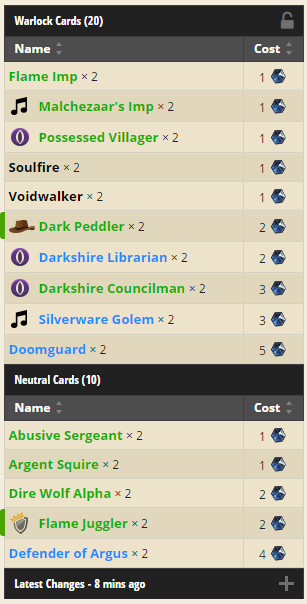Playing with [Malchezaar’s Imp] feels inherently unfair. Playing with more than one Imp in play feels like playing those old mono-blue draw-go Magic the Gathering decks from your best friend’s basement in the late-nineties. Your hand is always full and you have answers for everything.
Need to remove a threat? [Soulfire]. Need to deal the last few points of damage? [Doomguard]. Need to discover an answer? [Dark Peddler].
Okay the deck isn’t perfect, but it doesn’t need to be. It just needs to be fast, and that’s where it really shines. To be honest, it isn’t the most complicated deck to pilot, but it does have a lot of nuanced decisions to make and you can easily play yourself out of the game as early as in the mulligans.
How to Mulligan with Disco Warlock
This may sound obvious but you want [Malchezaar’s Imp]. You don’t want [Doomguard] in your opening hand. After that it kind of depends a bit on the match-up and a bit on your early tempo. But rule number one is to keep [Malchezaar’s Imp].
Even though your mana curve is very low, you also really don’t want to have [Doomguard]s and Defender of Argus in your opening hand. The odds of being able to mulligan them for lower-cost cards is incredibly high.
Remember, the goal to any good Disco Lock opening is tempo. You want to generate an early board presence and maintain it. Having [Silverware Golem] only works if you happen to have a way to discard it early like [Soulfire] or [Darkshire Librarian]. Otherwise it’s not building tempo.
[Darkshire Councilman] is another card that is difficult to decide on keeping in your opening hand. If you’re on the draw and can use the Coin to put it into play on turn two then it might be worthwhile. On the play it isn’t generating a lot of tempo on turn three.
Most of this decision-making is pretty independent of match-ups. Where you’re going to have to evaluate your match-up in the mulligan is in which one and two-drop creatures are worth keeping and which ones you want to send back. [Voidwalker] and [Argent Squire] are pretty good against aggressive decks while [Flame Imp] and [Dire Wolf Alpha] are better in matches where you want to get aggressive early (like Hunter and Shaman).
Playing the Game
This goes hand-in-hand with the mulligan decisions you’re going to make, but in order to get the right kind of tempo going you need to build an early board presence. Other decks, especially control decks, will easily punish you if you fall behind on board presence.
Tempo and board presence go hand-in-hand. Most of the time gaining tempo is similar to gaining card advantage, but this isn’t always the case. It might be worth it to just discard two cards to put [Doomguard] into play because it will gain you momentum.
It’s incredibly easy to generate card advantage with this deck but incredibly difficult to keep it. Your minions are all very fragile, hence the need for a card like [Defender of Argus] to improve your ability to survive. You can quickly fall behind and then you’ll be relying on your hero power to get you back in the game which could prove fatal.
Closing Out the Game
Disco Warlock has a few linear paths to victory. On the plus side, your lines of play develop very rapidly. On the other hand they are very predictable and can be easily exploited. This means it’s critical that you watch out and don’t fall into traps.
Plan A is to simply overwhelm your opponent with board presence and hit them in the face for thirty damage. There’s a lot of advantages to this plan, most importantly the fact that you can close out games before your opponents can disrupt it. You’ll find this is especially effective against decks that close out games in the late-stages like Hunter, Priest, and Mage. Obviously you need to watch out for board sweeping effects like [Flamestrike] and [Lightning Storm].
Plan B is to whittle away at your opponent’s life while trying to control the board and then finishing them off with high damage dealers like [Darkshire Councilman] and [Doomguard]. This is a safer plan against decks that will try to counter your board presence like Shaman, Paladin, and Warrior. The thing to watch out for here is taunt creatures like [Tirion Fordring] or [Thing from Below].
Plan C is the Combo Plan where you simply generate enough card advantage to Counter your opponent’s combo. This is how you’ll win the mirror match against other Warlock decks, and also how you can defeat those pesky Rogue combos and Druid combos. You’ll eventually win with either Plan A or Plan B, but getting your engine going before your opponent does is your best path to victory.
Final Thoughts
I was able to get into the high teens playing Disco Warlock in September. I’m definitely tempted to continue playing it next month. The speed at which it can close out games against weaker opponents makes it a very alluring deck to use to climb up the lowest rungs of the ladder.
Next month, at the very least, I plan on starting off with Disco Warlock. I’m still working on The League of Explorers adventure, so once I finish that and get [Huge Toad], [Brann Bronzebeard], [Raven Idol], and [Mounted Raptor] I may switch things up and play Druid since I picked up [Cenarius] in the Welcome Bundle last week.
Rich has been playing Hearthstone on and off since the closed beta and has a golden E.T.C. to prove it. He enjoys playing Warlock on the ladder and wishes he could get more than five wins in an Arena run. He’s trying desperately to figure out how Hunters always seem to have Call of the Wild on curve.


